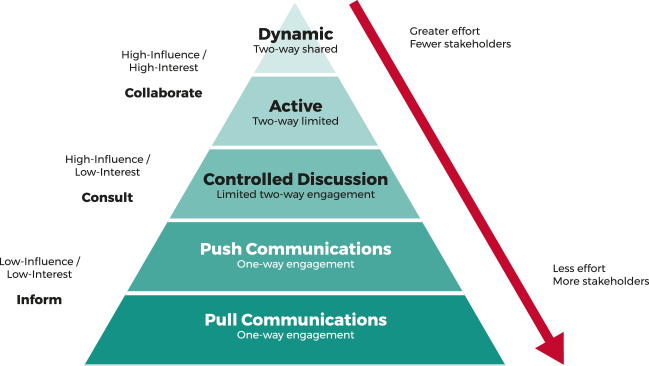Collaborating with stakeholders is an essential part of stakeholder management and of the work that needs to be done for any project to move forward and succeed.
When we consider the four different stakeholder engagement levels - inform, consult, involve and collaborate - stakeholder collaboration sits at the highest level in the communication pyramid. It's the active and dynamic level in the hierarchy of engagement.
Let's go through the process of collaborating with your stakeholders, who you should be collaborating with, and what you need to do to make it successful.
Stakeholder collaboration in the communication pyramid
Once you have identified, categorised your stakeholders and planned your communication to inform and consult with stakeholders, it's time to move to the Dynamic level of communication.
Stakeholder collaboration is a two-way exchange of information that is not constrained. It requires greater effort, however, it involves fewer stakeholders thant the lower levels of engagement.

Who are the stakeholders you need to collaborate with?
This collaboration process involves the high-interest/high-influence stakeholders of your project.
These are you key stakeholders. Due to their position and experience, they possess a wealth of knowledge, expertise, and influence within the project's sphere. They can act as advocates, helping to garner support from other stakeholders and key decision-makers.
Their involvement lends credibility and legitimacy to the project, facilitating smoother implementation and overcoming potential obstacles.
Your collaboration with stakeholders that belong to the Dynamic engagement level must happen on a continuous basis, with shared responsibility for the health of the project.
How to create a collaboration process with your stakeholders
Due to their influential positions and extensive expertise, it is crucial for these stakeholders to actively contribute to the everyday running of your project.
And in order to do so, you have to create an environment that facilitates this collaboration. Your stakeholders must be able to:
- Have access to all reports and documentation
This includes shared files on your stakeholder management system. If you use the Google G-Suite as your cloud repository, they must be able to access Google Docs, Sheets, Forms, and Calendar. If you use a tool like Sharepoint as your cloud infrastructure, they must have an email account that gives them access to your project's current files and archives.
- Co-author processes and documents
You should have processes and documents authored or co-authored by these stakeholders that take advantage of their unique value to your project. They wouldn’t be high-power stakeholders if they didn’t have that kind of value.
- Be an integral part of the decision-making process
That means you collaborate with them directly to get their buy-in.
- Be accessible
They must be accessible on your stakeholder management tool and recognised by name in the project communication plan in both the stakeholder management section and the project team section.
By including these influential stakeholders in the collaboration process, you tap into a powerful network of support, expertise, and resources, enhancing the project's overall chances of success.
How to get stakeholders to agree on collaborating
Stakeholder collaboration can often be challenging due to various factors:
- Many stakeholders have busy schedules and find it difficult to allocate time for collaboration;
- Others are located in different regions or countries and may face logistical challenges in terms of coordinating meetings and aligning their schedules;
- Furthermore, financial benefits can also create conflicts of interest, as stakeholders may prioritise their own financial gains over the collective success of the project - or they may not see the direct financial benefit of it.
To get these stakeholders on board you must providing them with a clear reason why their collaboration is essential - emphasise the benefits of their collaboration, show them their input can have a real impact, that they have the power to decide and that you want your decisions to consider their needs and views.
Highlight the benefits of collaboration so they can understand the value they bring to the project and feel motivated to actively participate.
By addressing their concerns, providing continuous communication channels, and involving them in decision-making processes, stakeholders are more likely to buy into the collaboration process and contribute to the project's overall success.
Collaborating with stakeholders using digital tools
Connecting with high-power stakeholders using digital tools makes the collaborative process much quicker and easier than relying on traditional methods - not to mention they can be more likely to engage with you if you are able to provide a good engagement experience.
The time saved for you can be reinvested into keeping the project moving forward while the proactive and dynamic digital collaboration keeps stakeholder concerns from slipping through the cracks.
Digital channels bring great power to collaboration with stakeholders and at a minimal cost.
Savvy organisations choose cloud collaboration software that offers all the tools and features to support good relationships and track all data.
The primary benefit of using digital channels in accomplishing stakeholder collaboration is that it makes work simpler and faster.
Tractivity is streamlining stakeholder collaboration for many organisations in the public and private sectors. Contact us to learn more about how we can help you improve the way you collaborate with your stakeholders.

